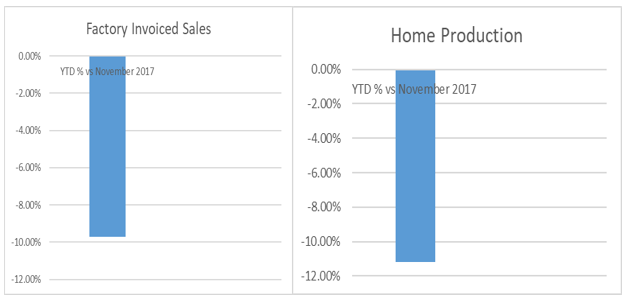NEW MARKET
Demand for new Light Commercial Vehicles (LCVs) in May increased 5.4% versus May 2018, with 29,142 new vehicles registered. Demand for lower emission vehicles aided by attractive market incentives continues to drive the demand. May returned increases of 14.0% in the sub 2.0 tonne sector, 10.2% in the 2.0-2.5 tonne sector and 5.3% in the 2.5-3.5 tonne sector. Offsetting some of these increases was a 1.8% decline in the pickup sector.
After five months of 2019, year to date (YTD) registrations of new LCVs stand at 156,489. This is a 7.5% increase on the 145,514 registered over the same period in 2018.
Top five LCV registrations

The September introduction of the Worldwide Harmonised Light Vehicle Test Procedure (WLTP) for LCVs has seen many dealers clearing NEDC compliant stock in preparation. Many fleets and businesses are taking this opportunity to replace older vehicles rather than waiting for WLTP compliant versions later in the year. It is possible, that the introduction of WLTP could lead to supply constraints and longer lead times through quarter four as factories around the world ramp up UK production of WLTP compliant LCVs.
USED MARKET
Overview
The LCV wholesale market proved unpredictable in May as two bank holidays and softer retail activity impacted buyer demand. Well-presented and accurately valued stock in the best condition resulted in professional buyers bidding strongly. With the steady increase in stock availability over the last quarter, similarly specified vehicles not professionally managed into the marketplace, have seen prices come under downward pressure. Realistic reserves have kept buyers engaged however; tired and damaged vans are continuing to prove difficult to shift.
Nonetheless, there is a good stock mix available, with something to suit everyone’s budget. With Euro 5 and older vehicles accounting for over 90% of all stock sold at auction, most buyers remain happy trading in vehicles that are at least three years old.
It was clear, however, that buyers were exercising caution, as the average first-time conversion rate fell to 76%, over 10% lower than May 2018.
Small Vans – 30% of overall sales
In the small van segment, there is still huge demand for the PSA products of Berlingo and Partner. This small van ticks plenty of boxes when it comes to reliability, economy and specification. 3-5 year old Caddys have sold well during the month, as have similar age Combo and Doblo. Older Astravan and Transit Connect are irregular sightings nowadays, but straight examples continue to perform well.
Medium Vans – 36% of overall sales
The best presented higher specification vans continue to perform strongly. The Transit Custom is a regular sight at auction, resulting in downward pressure on all but the nicest examples. Crew vans continue to be top of the popularity stakes, generating good prices for vendors. Increasing volumes of latest shape Dispatch and Proace have allowed their prices to firm. Demand for Euro 6 stock has plateaued of late, with many professional buyers struggling to find customers at this uncertain economic time.
Large Vans – 18% of overall sales
Used buyers in this sector are demanding higher specification models, especially metallic colours. The Ford Transit Trend, Citroen Relay Enterprise, Peugeot Boxer Professional and Renault Master Business + models are most in demand, especially short and medium wheelbase examples. Similarly, buyers pay premiums for curtain sider Transit or Sprinter chassis for the right stock. Tidy, low mileage examples of a drop sider or tipper continue to attract buyer attention and solid prices.
4×4 Pickups – 16% of overall sales
Stock availability is unfavourably high at present with vendors holding too much similar stock. Only the nicest examples, priced to sell, have found success. High specification L200 Barbarian, L200 Warrior and Navara Tekna have sold in decent volumes, whilst the Amarok Highline and Ranger Wildtrak have generally underperformed. Any 4×4 fitted with an automatic gearbox has tended to fare better. Conversion rates improved for older examples of Ranger, Hilux, L200 and Navara.
This article was originally written for the Commercial Fleet blog.

 Close
Close
